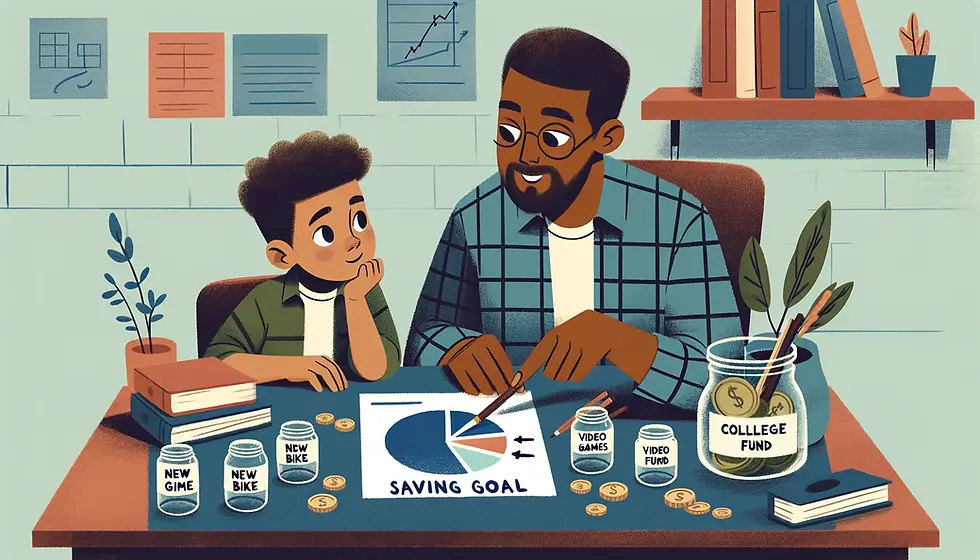Inspiring Future Goals: How Encouraging Kids to Dream Shapes Financial Values
- Ben Hofstetter
- Feb 29, 2024
- 8 min read
Hey there, amazing parents! Today, we're diving deep into something close to my heart: teaching Financial Values to Kids. As someone who's spent years helping families navigate the world of personal finance, I've seen firsthand the incredible impact that nurturing dreams and setting goals can have on a child's financial future. Let's explore how we can inspire our little ones to dream big and develop solid financial values along the way.
Table of Contents

Understanding the Connection Between Dreams and Financial Values
Dreams really do fuel our drive. They're the seeds of our future aspirations, pushing us to reach for the stars, sometimes quite literally in the case of aspiring astronauts! But here's the thing: while dreaming is often seen as a fanciful activity, it actually plays a crucial role in developing robust financial values from a young age.
When we encourage children to dream, we're not just indulging their imaginations; we're teaching them to envision a future they can aspire to. This vision becomes a powerful motivator, guiding them towards setting goals and understanding the value of resources, including money, as tools to achieve those dreams.
Dreams Foster Financial Literacy
Imagine a child dreaming of becoming an astronaut, a scientist, or an artist. These dreams open up avenues to introduce financial literacy in a context that's meaningful and exciting to them. Here's how:
Contextual Learning: Discussing the financial aspects of their dreams helps children understand money's value and its role in achieving goals. It's a natural segue into lessons about saving, budgeting, and financial planning.
Engagement: Kids are more likely to be engaged and absorb information when it's related to their interests and dreams. This engagement is a golden opportunity to instill fundamental financial concepts.
Building Blocks for Success
The correlation between early goal-setting and later financial success isn't just anecdotal; it's supported by research. Here's why establishing these building blocks is so important:
Goal-Oriented Mindset: By linking dreams to goal setting, children learn to approach their aspirations systematically. This mindset, when applied to financial planning, fosters a proactive rather than reactive relationship with money.
Financial Awareness: Understanding that achieving dreams requires resources encourages children to be financially aware from a young age. They learn to save, budget, and make financial plans, viewing money as a tool rather than an end in itself.
The Ripple Effect of Dreaming Big
Encouraging kids to dream big has a ripple effect that goes beyond financial literacy. It fosters qualities like resilience, perseverance, and creativity. When kids learn to align their financial decisions with their goals, they're not just planning for the future; they're actively shaping it. They learn that financial setbacks are just obstacles, not roadblocks, on their path to achieving their dreams.

The Role of Parents in Shaping Financial Dreams
As a parent, your approach to money management is the blueprint your children will likely follow. You're much more than just a provider; you're the first and most influential financial educator your child will ever have. The attitudes, values, and practices you model regarding money management are absorbed by your kids, consciously and unconsciously, shaping their financial behaviors and beliefs.
Be a Financial Role Model
Being a financial role model is about more than just showing your kids how to save or spend wisely; it's about embodying the financial values you want to instill in them. Here's what that looks like in practice:
Transparency: While it's not necessary to share every detail of your financial situation, being open about the basics can demystify finances for your children. Discussing your budgeting process, how you save for vacations, or why you're choosing to cut back on certain expenses can provide real-world context.
Lead by Example: Practice what you preach. If you emphasize the importance of saving, let your kids see you doing it. This could mean contributing to a savings account, investing, or simply setting aside money for a family goal.
Open Conversations
The way we talk about money can have a lasting impact on how children view financial matters. Open, positive conversations about finances can help demystify this often-taboo subject, making it a natural part of daily life.
Encourage Questions: Make it clear that it's okay to ask questions about money. Whether they're asking about the cost of groceries or why you need to work, each question is an opportunity to teach valuable lessons about earning, spending, and saving.
Dream Together: Talk about dreams and goals as a family. What does your child dream of doing or buying? Use these discussions as springboards for conversations about financial planning and goal-setting. For example, if they want to buy a new video game, talk about ways they could save their allowance or earn money to reach that goal.
Making Financial Values Relatable
Integrating financial lessons into everyday activities makes learning about money management natural and engaging. For instance, involve your kids in budgeting for a family outing or let them help with grocery shopping and comparing prices. These activities can teach budgeting skills, the value of money, and decision-making.
The Impact of Financial Storytelling
Sharing stories of your financial successes and failures can be incredibly powerful. Kids need to know that financial setbacks aren't the end of the world but rather learning experiences. Share how you overcame a financial challenge or what you learned from a money mistake. This not only humanizes you but also teaches resilience and the importance of learning from mistakes.

Practical Ways to Encourage Kids to Dream and Set Financial Goals
Engaging children in activities that blend their aspirations with financial planning can be both enlightening and entertaining. Here's how to make the journey towards financial literacy a fun and integral part of growing up.
Setting Up a Dream Board
A dream board is a fantastic visual tool that brings dreams to life. Here’s how to make it a fruitful exercise:
Visualize Goals: Use magazines, drawings, or printouts to depict their goals. It could be pictures of places they want to visit, items they wish to save for, or professions they aspire to.
Incorporate Financial Elements: Alongside images of their dreams, add elements that represent savings or budgeting. For example, if they dream of buying a bike, attach a savings tracker or a piggy bank image to symbolize the financial goal.
This visual and interactive approach not only makes goal setting more tangible but also introduces the concept of financial planning in a kid-friendly manner.
Financial Goal Setting
Turning dreams into actionable financial goals is a vital skill. Here’s how to guide your children through this process:
Specific Goals: Help them define specific goals (e.g., saving $50 for a new game). This teaches the importance of setting clear, achievable objectives.
Action Plans: Work with them to develop a simple action plan. This might involve setting aside a small amount of their allowance each week. It’s a great way to introduce the concept of budgeting and saving over time.
Celebrate Milestones: Recognize and celebrate when they hit milestones towards their goals. This reinforces positive behavior and keeps them motivated.
Learning Through Experience
Real-world experiences are invaluable for teaching kids about the value of money and hard work. Here are a few ways to provide these lessons:
Entrepreneurial Projects: Encourage them to start a simple business venture, like a lemonade stand or a yard sale. This teaches them about earning money, cost management, and profit calculation.
Saving for a Purchase: Guide them in saving for something they want, rather than buying it for them outright. This experience teaches patience, discipline, and the satisfaction of achieving a goal.
Financial Responsibility: As they grow, gradually introduce more complex financial concepts through allowance management, bank accounts, and budgeting for personal projects.

Integrating Financial Education with Goal Setting
Making financial education exciting and relevant involves strategic integration with your child's goals and dreams. Here's how you can make this integration seamless and effective:
Age-Appropriate Concepts
It's crucial to ensure that the financial lessons we share with our children align with their developmental stage and personal interests. Tailoring discussions to be age-appropriate ensures that children are both capable of understanding the concepts and finding them relevant to their current life experiences.
Young Children: For younger kids, introduce basic concepts of money through play. Games involving currency can help them understand the value of different coins and bills. Setting simple saving goals, like saving for a small toy, introduces the concept of delayed gratification and savings.
Pre-Teens: As children grow, introduce more complex topics such as budgeting for their wants versus needs, the concept of earning interest from savings, and the basics of how banks work. Encourage them to set slightly more ambitious savings goals, perhaps for a video game or a bicycle, teaching them to budget their allowance or earnings from chores.
Teenagers: For teens, discussions can become more sophisticated, including the principles of investing, the importance of saving for the future (like college or a car), and even basics of credit. At this stage, involving them in family financial planning discussions can be incredibly beneficial, offering real-world context to the concepts they're learning.
Real-Life Scenarios
Incorporating financial literacy into daily life through real-life scenarios makes learning about money management practical and immediate. Here are ways to embed financial education into everyday experiences:
Shopping Decisions: Involve your child in shopping decisions to discuss budgeting and spending choices. Comparing prices, understanding discounts, and discussing the need versus want aspect of purchases can offer practical budgeting lessons.
Saving Goals: Use their personal saving goals (like buying a new game or gadget) to teach about planning and delayed gratification. Discuss how saving a certain amount from their allowance or gift money can help them achieve their goals.
Family Financial Planning: Involve older children in discussions about family financial planning, such as budgeting for vacations, home improvements, or other significant expenses. This not only teaches them about managing larger budgets but also the value of collective goal setting and saving.
Investment Basics: For older kids, discussing investment basics using examples from everyday life (like a popular company they know or a new technology) can make the concept of investing more relatable and interesting.
Making It Fun and Engaging
Use Apps and Games: Leverage technology with educational apps and games designed to teach financial concepts in an engaging way. Many apps gamify saving, investing, and budgeting, making these concepts more accessible and fun for children.
Set Challenges: Create saving or budgeting challenges with rewards at the end to motivate them. For example, if they save a certain amount by the end of the month, they earn a small bonus towards their goal or a family outing.
Encourage Exploration: Support your child's interest in financial learning by providing books, videos, and other resources that explore financial concepts in an age-appropriate and engaging manner.
Wrapping Up
Encouraging kids to dream is about so much more than just wishful thinking. It's a foundational step in building strong financial values and setting them up for a future filled with success. By playing an active role in their financial education, you're not just helping them dream; you're helping them achieve.
Got any tips or stories about teaching financial values to kids? Share them in the comments below! And if you're hungry for more insights on raising financially savvy kids, don't forget to subscribe. Together, let's make a difference in our children's financial future!
Remember, instilling financial values in kids is not just about teaching them to save or spend wisely; it's about empowering them to dream big and work towards those dreams with confidence and clarity. So, let's get started on this journey together, nurturing those little dreams into big realities.
Interested in Free Lesson Plans?
Visit our site and become a member! When you do, you'll get access to our member only section, including free downloads of Lesson Plans and Presentation slides to use when teaching personal finance to your children!
Interested in Our Books and Services? Click the link below to visit our store!
Become an Affiliate Seller!
Interested in Joining our team as an Affiliate Sales member? We offer a competitive 10% flat-rate commission on all sales!

Comments